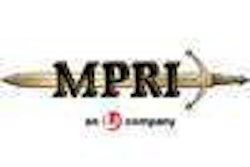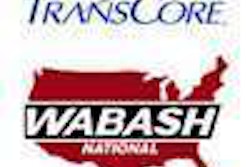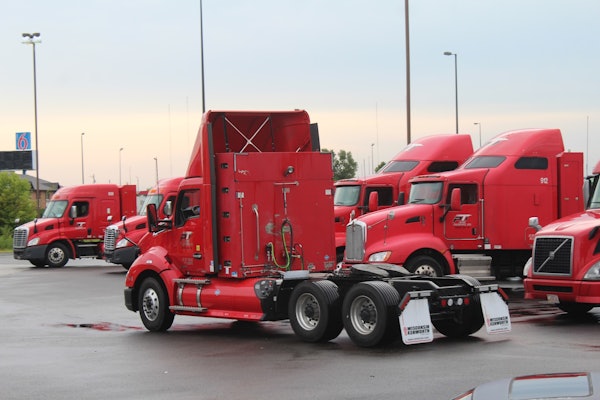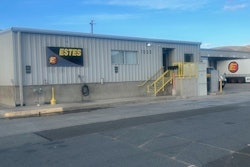Cat-branded truck to be available in 2011
Caterpillar Inc. and Navistar International Corp. announced last month they had signed a definitive agreement to produce Caterpillar heavy-duty vocational trucks for sale in North America and had formed a 50/50 joint venture to pursue commercial truck opportunities outside of North America and India. The agreement, which is subject to regulatory approval, finalizes a planned alliance announced in June 2008.
The new Caterpillar trucks, to be unveiled in late 2010, will be co-developed by Caterpillar and Navistar and built at Navistar’s facility in Garland, Texas. They will be sold and serviced exclusively through the Caterpillar North American dealer network.The North American truck deal is subject to various closing conditions, including the execution of the related strategic alliance agreement and certain other ancillary agreements, the companies said.
The Caterpillar-branded trucks are expected to go into production in early 2011 – a timeframe that coincidentally parallels the expected availability of Navistar’s MaxxForce 15 engine, for which Caterpillar will supply blocks, cranks, heads and other foundation components. Caterpillar announced in June 2008 – simultaneous with the initial announcement of the Navistar strategic alliance – that it will not market its own on-highway heavy-duty diesel engine once the next round of emissions regulations kick in Jan. 1, 2010.
In a conference call with journalists, Navistar and Caterpillar officials gave few details of the new Cat truck. It will feature an all-aluminum cab and will incorporate some components and systems proprietary to Caterpillar. The engine also will be badged as Caterpillar but will be built by Navistar. And the transmission options are expected to be the Caterpillar CX and Allison.
– Avery Vise
Peterbilt 384 lands SmartWay status
Peterbilt announced that the Model 384 has joined Models 387 and 386 in certification as fuel-efficient and environmentally-friendly by the U.S. Environmental Protection Agency’s SmartWay program.
The Model 384 is equipped with Peterbilt’s new proprietary Aero Package combining a roof fairing and trim tabs, a sleeper roof transition, enhanced chassis fairings, an aero battery/tool box, a composite sunvisor, a 3-inch sleeper extender and aerodynamic mirrors.
The Aero Package, also available on the Model 386, provides an estimated 12 percent improvement in fuel efficiency gains over a nonequipped model, the company says. Peterbilt markets the Model 384 especially for tanker, pickup-and-delivery, regional and short-haul applications.
Engine emissions fight continues
Proponents of SCR, EGR spar at MATS
Proponents of the two 2010-compliant heavy-duty engine technologies battled at press events during the Mid-America Trucking Show in Louisville, Ky., in March. The alternatives will reduce particulates and NOx emissions to meet the 2010 U.S. Environmental Protection Agency regulations.
Navistar, the lone engine maker not using selective catalytic reduction to meet the new regulations, lobbed shots at its competitors during a customer event where it debuted its 15-liter MaxxForce engine. SCR involves complexity, payload, packaging, weight issues and hassles, Dee Kapur, president of International’s Truck Group, told attendees. “It means adding five new major emission-critical components,” Kapur said.
Navistar’s solution – enhanced exhaust gas recirculation – means no added hardware and no new, complex electrical system, Kapur said. For medium and severe-service, advanced EGR is “a no-brainer,” he said. Navistar’s 2010 engines will produce 0.5 grams of NOx and will use EPA credits previously earned by exceeding EPA emissions goals to achieve the required 0.2-gram limit.
“SCR is not a new development,” said Chris Patterson, outgoing president and chief executive officer of Daimler Trucks North America, during a panel discussion, in which SCR proponents sought to dispel what several participants deemed “misinformation” about the technology.
Patterson cited the more than 200,000 SCR-equipped trucks Daimler has operating in Europe. The technology “has already saved our customers nearly half a billion dollars in fuel costs, compared to other technologies,” he said.
All engine makers use EGR technology today, said Denny Slagle, president and CEO of Mack Trucks. “It generates a lot of heat and puts stress on the engine,” Slagle said. “We manage well today, but we’ve reached the limit of what we can do using EGR.”
Engine makers on the panel – Daimler, Mack, Volvo and Cummins – cited fuel savings of about 5 percent compared to 2007 technology engines.
One of Navistar’s biggest arguments against the use of SCR is that it makes the owner and driver accountable for emissions for the first time, Kapur said, because diesel exhaust fluid must be added periodically to maintain appropriate emissions levels. That initially was a concern for EPA as well, said Byron Bunker, with EPA’s Office of Transportation and Air Quality, during his panel presentation. “We acknowledged that [SCR] would bring the trucker into the program more than before,” Bunker said. “It was a concern. But the industry has done an absolutely fantastic job of answering that concern.”
Bunker said EPA has not endorsed any one means of meeting the 2010 standards.
DEF itself was a source of debate. Navistar officials said the fluid freezes at 12 degrees Fahrenheit and can become a toxic ammonia gas at 122 degrees. But Barry Lonsdale, president of Terra Environmental Technologies, a supplier of the urea used in DEF, told panel attendees that the fluid is nonhazardous based on criteria set by the Occupational Safety and Health Administration.
“Let’s remember diesel fuel is a hazardous substance,” Patterson added. “This is relatively benign.” And if DEF is altered by temperature or other factors, “it won’t affect engine performance or fuel economy and won’t harm the aftertreatment or engine,” he said.
Referring to media reports that DEF will be available at 500 U.S. fueling stations, Kapur expressed concern about adequate availability. Representatives from Pilot Travel Centers and TA/Petro who participated in the panel sought to allay any concerns. Both companies said they will begin rollout of DEF later this year. “Our plans include flexibility to meet demand when it ramps up,” said Tom O’Brien, president and CEO of TA/Petro.
Looking to the future, Kapur cited aftertreatment options under development that would eliminate the need for urea altogether. But panelists dismissed such technologies. “We don’t see it [happening] on anything close to a reasonable horizon,” said Jim Kelly, president of Cummins engine business.
“Even if it is technologically viable, it would add cost and waste,” Patterson added.
– Linda Longton and John Baxter
Rush, Peterbilt show the green
Attendees of the Rush Enterprises/Peterbilt Go Green event had the opportunity to test-drive Peterbilt’s greenest vehicles, including the Model 386 heavy-duty hybrid, which is still in development.
The green movement, with its evolving and increasingly stringent regulations, is “a tidal wave, and it’s only getting bigger coming at us,” Rusty Rush, president and chief executive officer of Rush Enterprises, told attendees of the daylong event, held April 1 at Angels Stadium in Anaheim, Calif.
The Go Green event, which drew about 160 fleet customers and representatives from the trucking media, showcased Peterbilt vehicles featuring alternative technologies designed to lower emissions and improve air quality while reducing U.S. dependence on foreign oil and taking advantage of domestic resources such as natural gas.
Attendees heard presentations on the latest green technologies from Peterbilt, Cummins, Eaton and Westport, along with details on available grants and tax incentives to encourage fleets to convert to greener equipment. Attendees also had the opportunity to experience firsthand Peterbilt vehicles equipped with hybrid diesel-electric, diesel-hydraulic and liquefied natural gas engine technologies.
By 2010, a three-axle day cab might go from $80,000 to $100,000 because of increased equipment costs, said Dan Chilson, fleet and facility supervisor at Classic Distributing & Beverage Group, based in City of Industry, Calif. “If you can recoup that $20,000 by going green, it’s a win-win all around,” he said.
LoneStar named ATD’s truck of the year
The American Truck Dealers last month announced that the International LoneStar is the association’s inaugural ATD Commercial Truck of the Year. The selection was announced during ATD’s 2009 Convention & Exposition in the Washington, D.C., area.
The LoneStar was chosen by a judging panel of journalists from leading truck publications in North America. It was chosen because of its design, innovation, quiet cab and space utilization, said past ATD Chairman George Grask. For example, a fold-down Murphy bed-style bunk allows conversion from a sofa to a full 42-inch-wide bunk with a one-piece spring mattress.
The other nominees were the Freightliner Cascadia, Kenworth T660, Mack Titan and Peterbilt Model 386. In 2010, two ATD Commercial Truck of the Year awards will be presented: a heavy-duty truck (Class 8) and a medium-duty truck (Classes 3-7).
In Brief
American Honda Motor Co. introduced a Class 8 Peterbilt Model 386 hybrid diesel-electric truck into its truck fleet at its parts center in Alpharetta, Ga. The truck, operated for Honda by UPS Freight Truckload, will be used along a hilly route in Tennessee and a relatively flat one in Georgia in order to evaluate fuel economy in various driving conditions. Honda will alternate the hybrid with a standard diesel truck in order to compare performance.
Smith Electric Vehicles U.S. Corp. announced plans to assemble its all-electric zero-emissions commercial vehicles in Kansas City, Mo. The new assembly plant will be located at Kansas City International (KCI) Airport and is expected to create 120 jobs by 2010.
International Truck and Engine Corp. introduced the Harley-Davidson limited-edition LoneStar, which is available for order in a sleeper configuration, with production starting in June. Only 250 Harley-Davidson special-edition LoneStars will be built in 2009.
Kenworth’s AG400L tandem rear suspension for its Class 8 vehicles now is available for order. The disc brake-compatible AG400L is a 40,000-pound-rated highway rear suspension system for the T660, T800, T2000 and W900.
Detroit Diesel’s DD16 engine will enter production for the Western Star 4900 series in March 2010 and the Western Star 6900 in July 2010. Detroit Diesel says the DD16 is its most powerful engine offering and will be equipped with BlueTec emissions technology.
Goodyear Commercial Tire Systems is expanding its on-highway service network through a relationship with Bosselman’s Boss Truck Shops.











